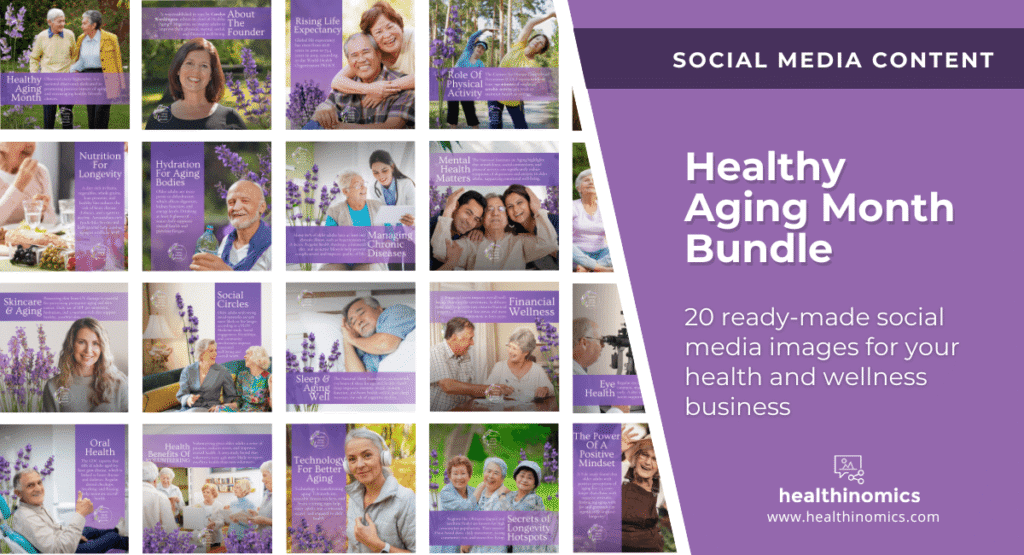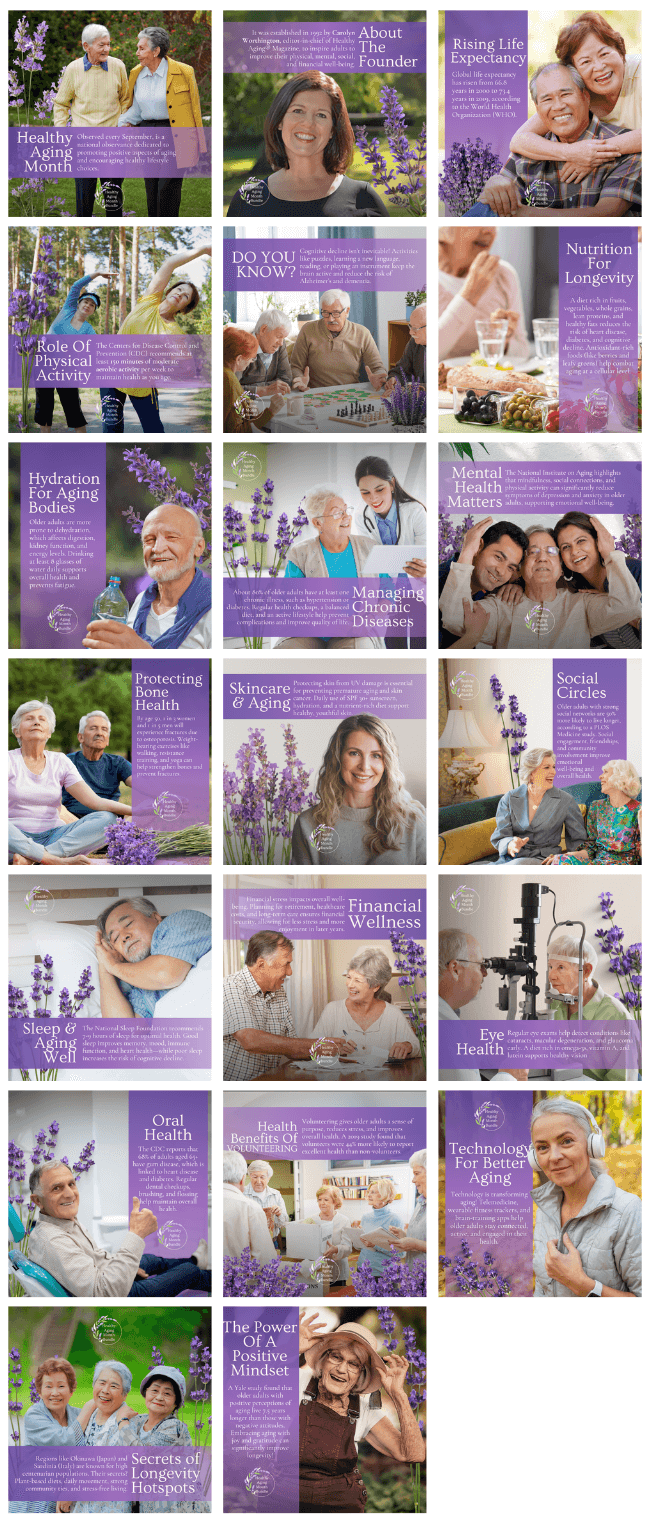Healthy Aging Month is a national observance held every September to spotlight the positive aspects of growing older and to encourage individuals—especially those 45 and up—to take charge of their health, well-being, and mindset as they age. This campaign serves as a gentle reminder that aging doesn’t mean slowing down—it means living smarter, healthier, and with purpose.
Sharing content around Healthy Aging Month on social media is not just informative; it’s empowering. It helps dismantle age-related stigmas, sparks important conversations about preventive care, and motivates people to adopt habits that support long-term vitality like staying active, eating well, managing stress, and nurturing social connections.
These posts can deeply resonate with followers who are navigating midlife transitions, caring for aging family members, or simply looking to feel their best. By sharing this kind of content, we help build a community that values aging with strength and intention, one post at a time.
Inside The Bundle
BONUS 20 sample captions for you to share with your bundle!
BONUS Editable Canva Template!
The Healthy Aging Month bundle includes 20 beautiful pieces of visual content:

Image Content
1. Healthy Aging Month (September) 🌿
Observed every September, Healthy Aging Month is a national observance that promotes positive aging and encourages lifestyle habits that support physical, mental, and emotional well-being. It reminds older adults that it’s never too late to improve their health and embrace an active, fulfilling life.
2. About the Founder
Established in 1992 by Carolyn Worthington, editor-in-chief of Healthy Aging® Magazine, this initiative inspires adults to prioritize well-being by focusing on physical health, mental sharpness, social connections, and financial stability for a fulfilling aging experience.
3. Rising Life Expectancy
Global life expectancy has increased from 66.8 years in 2000 to 73.4 years in 2019, according to WHO. This rise is due to improved healthcare, better nutrition, and healthier lifestyles, but maintaining longevity depends on proactive health choices.
4. The Role of Physical Activity
The CDC recommends 150 minutes of moderate aerobic exercise per week to support cardiovascular health, mobility, and muscle strength. Activities like walking, swimming, and resistance training can enhance balance and reduce fall risks.
5. Do You Know?
Cognitive decline isn’t inevitable! Activities like puzzles, learning a new language, reading, or playing an instrument keep the brain active and reduce the risk of Alzheimer’s and dementia.
6. Nutrition for Longevity
A diet rich in fruits, vegetables, whole grains, lean proteins, and healthy fats reduces the risk of heart disease, diabetes, and cognitive decline. Antioxidant-rich foods (like berries and leafy greens) help combat aging at a cellular level.
7. Hydration For Aging Bodies
Older adults are more prone to dehydration, which affects digestion, kidney function, and energy levels. Drinking at least 8 glasses of water daily supports overall health and prevents fatigue.
8. Managing Chronic Diseases
About 80% of older adults have at least one chronic illness, such as hypertension or diabetes. Regular health checkups, a balanced diet, and an active lifestyle help prevent complications and improve quality of life.
9. Mental Health Matters
The National Institute on Aging highlights that mindfulness, social connections, and physical activity can significantly reduce symptoms of depression and anxiety in older adults, supporting emotional well-being.
10. Protecting Bone Health
By age 50, 1 in 3 women and 1 in 5 men will experience fractures due to osteoporosis. Weight-bearing exercises like walking, resistance training, and yoga can help strengthen bones and prevent fractures.
11. Skincare & Aging
Protecting skin from UV damage is essential for preventing premature aging and skin cancer. Daily use of SPF 30+ sunscreen, hydration, and a nutrient-rich diet support healthy, youthful skin.
12. Social Circles
Older adults with strong social networks are 50% more likely to live longer, according to a PLOS Medicine study. Social engagement, friendships, and community involvement improve emotional well-being and overall health.
13. Sleep & Aging Well
The National Sleep Foundation recommends 7-9 hours of sleep for optimal health. Good sleep improves memory, mood, immune function, and heart health—while poor sleep increases the risk of cognitive decline.
14. Financial Wellness
Financial stress impacts overall well-being. Planning for retirement, healthcare costs, and long-term care ensures financial security, allowing for less stress and more enjoyment in later years.
15. Eye Health
Regular eye exams help detect conditions like cataracts, macular degeneration, and glaucoma early. A diet rich in omega-3s, vitamin A, and lutein supports healthy vision.
16. Oral Health
The CDC reports that 68% of adults aged 65+ have gum disease, which is linked to heart disease and diabetes. Regular dental checkups, brushing, and flossing help maintain overall health.
17.Health Benefits of Volunteering
Volunteering gives older adults a sense of purpose, reduces stress, and improves overall health. A 2019 study found that volunteers were 44% more likely to report excellent health than non-volunteers.
18. Technology for Better Aging
Technology is transforming aging! Telemedicine, wearable fitness trackers, and brain-training apps help older adults stay connected, active, and engaged in their health.
19. Secrets of Longevity Hotspots 🌍
Regions like Okinawa (Japan) and Sardinia (Italy) are known for high centenarian populations. Their secrets? Plant-based diets, daily movement, strong community ties, and stress-free living.
20. The Power of a Positive Mindset ✨
A Yale study found that older adults with positive perceptions of aging live 7.5 years longer than those with negative attitudes. Embracing aging with joy and gratitude can significantly improve longevity!


